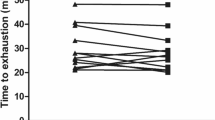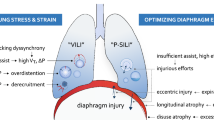Abstract.
At a given steady O2 consumption (\( \dot V{\rm O}_{\rm 2} \) ) in normoxia, cardiac output (\( \dot Q \) ) is inversely proportional to arterial O2 concentration (CaO2), so that O2 delivery (\( \dot Q{\rm aO}_{\rm 2} {\rm = }\dot Q\,C{\rm aO}_{\rm 2} \) ) is kept constant and adapted to \( \dot V{\rm O}_{\rm 2} \) . The matching between \( \dot Q{\rm aO}_{\rm 2} \) and \( \dot V{\rm O}_{\rm 2} \) keeps O2 return (\( \dot Q\overline {\rm v} {\rm O}_{\rm 2} = \dot Q{\rm aO}_{\rm 2} - \dot V{\rm O}_{\rm 2} \) ) constant and independent of \( \dot V{\rm O}_{\rm 2} \) and haemoglobin concentration ([Hb]). This may not be so in hypoxia: in order for \( \dot Q\overline {\rm v} {\rm O}_{\rm 2} \) to be independent of the inspired O2 fractions (FIO2), the slopes of the \( \dot Q \) versus \( \dot V{\rm O}_{\rm 2} \) lines should be greater the lower the CaO2, which may not be the case. Thus, we tested the hypothesis of constant \( \dot Q\overline {\rm v} {\rm O}_{\rm 2} \) by determining \( \dot Q{\rm aO}_{\rm 2} \) and \( \dot Q\overline {\rm v} {\rm O}_{\rm 2} \) in acute hypoxia. Thirteen subjects performed steady-state submaximal exercise on the cycle ergometer at 30, 60, 90 and 120 W breathing FIO2 of 0.21, 0.16, 0.13, 0.11 and 0.09. \( \dot V{\rm O}_{\rm 2} \) was measured by a metabolic cart, \( \dot Q \) by CO2 rebreathing, [Hb] by a photometric technique and arterial O2 saturation (SaO2) by infrared oximetry. CaO2 was calculated from [Hb], SaO2 and the O2 binding coefficient of haemoglobin. The \( \dot V{\rm O}_{\rm 2} \) versus power relation was independent of FIO2. The relations between \( \dot Q \) and \( \dot V{\rm O}_{\rm 2} \) were displaced upward and had higher slopes in hypoxia than in normoxia. However, the \( \dot Q \) changes did not compensate for those in CaO2. The slopes of the \( \dot Q{\rm aO}_{\rm 2} \) versus \( \dot V{\rm O}_{\rm 2} \) lines tended to decrease in hypoxia. \( \dot Q\overline {\rm v} {\rm O}_{\rm 2} \) was lower the lower the FIO2. A significant relationship was found between \( \dot Q\overline {\rm v} {\rm O}_{\rm 2} \) and SaO2 (\( \dot Q\overline {\rm v} {\rm O}_{\rm 2} \) =1.442 SaO2+0.107, r=0.871, n=24, P<10–7), which confutes the hypothesis of constant \( \dot Q\overline {\rm v} {\rm O}_{\rm 2} \) in hypoxia.
Similar content being viewed by others
Author information
Authors and Affiliations
Additional information
Received after revision: 9 January 2001
Electronic Publication
Rights and permissions
About this article
Cite this article
Anchisi, S., Moia, C. & Ferretti, G. Oxygen delivery and oxygen return in humans exercising in acute normobaric hypoxia. Pflügers Arch - Eur J Physiol 442, 443–450 (2001). https://doi.org/10.1007/s004240100553
Received:
Accepted:
Published:
Issue Date:
DOI: https://doi.org/10.1007/s004240100553




